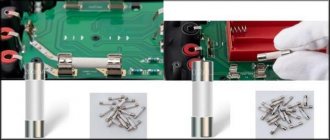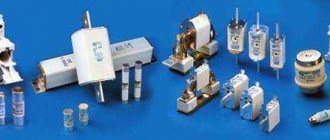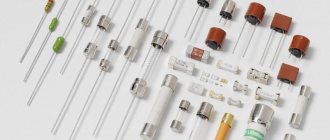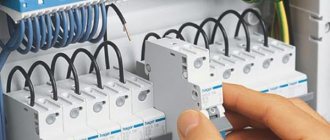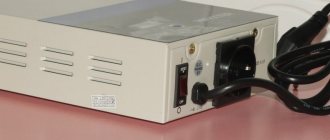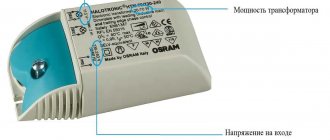Fuse groups
One of the means of protecting household appliances and equipment, as well as cables and wires, are fuses or fuses. They provide reliable protection against power surges and short circuits. There are various designs and types of these devices, designed for any current.
Until recently, fuses were inserted into plugs and were the only protection for an apartment or private house. In modern conditions, they have been replaced by more reliable reusable protective devices - circuit breakers. However, fuses have not lost their relevance today. They are installed in various devices and cars, protecting devices and electrical equipment from any negative consequences.
Fuses are divided into the following main groups:
- General purpose
- Fast acting
- Security semiconductor devices
- For transformer protection
- Low voltage
In order to make correct calculations and determine which fuse links are needed, it is recommended to take into account all the main parameters on which the fuse characteristics depend.
The main indicator is the rated current, the value of which is related to geometric and thermophysical parameters. At the same time, the power loss and excess temperature at the terminals are taken into account. The total current for the fuse depends on the rated current of the fuse link. The value of the rated current for the base is determined by the same indicator of the fuse insert installed in the fuse.
Selection of fuses based on motor starting type
Based on frequency and starting time, asynchronous electric motors are divided into two types:
- Units with easy starting (in pumps, metal-cutting machines, fans). They start quite rarely (no more than 15 times in 1 hour), the start-up process takes from 3 to 5 seconds.
- Units with heavy starting (in ball mills, centrifuges, cranes). They start more often (15 times in 1 hour) and the start lasts 10 seconds or more. For this type of engine, burnout of the insert during startup is unacceptable.
To calculate the rated current of the insert, the value of the motor starting current is divided by the starting conditions coefficient. The first value is determined using measurements, according to a catalog or passport. The second value is 2.5 for mechanisms with easy starting and from 1.6 to 2 for mechanisms with heavy starting.
It is important to first accurately determine the start-up time and measure the voltage at the inputs of the mechanism at the time of start-up, since false burnout of the insert is possible during nominal operation of the unit due to its oxidation and heating (as a result - a reduction in the cross-section and deterioration of the condition of the contacts).
Burning out of the insert during startup leads to the fact that the engine begins to operate in two phases and quickly breaks down. Therefore, if the level of sensitivity of the mechanism to short circuit allows, you need to choose inserts that are coarser than those based on the calculation results. Each engine requires a separate protection device. Installation of a common apparatus for several engines is permitted subject to the following conditions:
- low-power mechanisms;
- Overload protection devices and starting devices with sufficient thermal stability are installed in the circuit of each motor.
Operating principle of fuses
The principle of operation of disposable protective devices is very simple. Inside each of them there is a calibrated wire connecting the contacts. If the current value does not exceed the maximum permissible norms, it heats up to approximately 70 degrees. When the electric current exceeds the set rating, the heating of the wire increases significantly. At a certain temperature it begins to melt, resulting in a break in the electrical circuit. Wiring burnout occurs almost instantly. Because of this, fuses got their name - fuse link.
In different designs, the fuse link is selected in such a way that operation occurs at the set current value. During operation, fuses periodically fail and must be replaced. As a rule, they are not repaired, but many home craftsmen quite successfully restore them.
Since only the wire itself burns out, but the body remains intact, it is necessary to replace it and the device will continue to perform its functions. New technical characteristics are often not only not inferior to the old device, but also in many ways superior to it, since the quality of hand assembly is always higher than the factory one. The main condition is the correct choice of conductor material and calculation of its cross-section.
Replacing the fuse
When replacing a fuse, to avoid electric shock, be sure to unplug the electrical appliance!
There is an unspoken rule: if after the second replacement the fuse blows again, look for a fault in the electrical appliance itself. This means that the electrical appliance needs to be repaired.
Do not install a fuse at a higher current under any circumstances; such attempts will definitely lead to even greater damage to the device, up to the point of its being beyond repair!
Be careful when purchasing a new fuse. Correctly determine the type and current rating of the replacement candidate. It is better to purchase electronic components from trusted suppliers who guarantee product quality, such as Conrad Electronic. The full range of fuses can be found at the link - https://conrad.ru/catalog/predohraniteli_s_plavkoy_vstavkoy.
General calculation rules
In order to make the correct calculation of fuse links, it is necessary to take into account the rated voltage. This value should be such that the fuse switches off the electrical circuit. The main indicator is the minimum voltage provided for the base and fuse-link.
Another important indicator that should be taken into account in the calculations is the shutdown voltage. This parameter is the instantaneous value of the voltage that appears after the fuse or fuse link itself has tripped. As a rule, the maximum value of this voltage is taken into account.
Fuse repair
Typical people believe that fuses cannot be repaired; in fact, this is not the case. Most types of fuses can be repaired and given a second, third, etc. life. The fuse housing, as a rule, is destroyed extremely rarely, the wire inside burns out, and the repair consists of replacing it. The main task is to use a wire similar to the one in the fuse.
If you need to replace a fuse very quickly, but you don’t have a spare at hand, you can use the following method:
Remove the paint coating from a wire of a suitable diameter (clean it until it shines) and wind several turns around each fuse contact, then insert the fuse into the holder. This method is popularly called “bug”. With its help you can very quickly check the serviceability of the device, but it is not reliable and can be used as a temporary solution to the problem.
The next method is the so-called “factory” one. Repairs will require a soldering iron, and perhaps a Dremel or screwdriver, but the fuse after repair will look like it came straight from the factory.
Heat the ends of the cup contacts with a soldering iron and remove the solder from the holes in the ends using a toothpick or something similar. It happens that the holes are too small or completely absent, then you will have to drill them. Use a drill of small diameter 1 - 2 mm.
Pass a wire of a suitable diameter through the holes and solder it to the cup contacts.
The fuse is ready!
Selecting the diameter of the fuse wire
As written above, to repair a fuse, it is necessary to replace the burnt wire with one similar to the one that was in the fuse before it burned out.
Factory fuses use wires made of various metals: silver, copper, aluminum, tin, lead, nickel, etc. At home, it is unlikely that we will be able to determine the material of the wire of a blown fuse, and we also have ordinary copper wire at hand. But just in case, we present a table of wire diameters depending on the rated current of the fuse, containing, in addition to copper, aluminum, steel and tin.
| Fuse current, A | 0,25 | 0,5 | 1,0 | 2,0 | 3,0 | 5,0 | 7,0 | 10,0 | |
| Wire diameter, mm | Copper | 0,02 | 0,03 | 0,05 | 0,09 | 0,11 | 0,16 | 0,20 | 0,25 |
| Aluminum | — | — | 0,07 | 0,10 | 0,14 | 0,19 | 0,25 | 0,30 | |
| Iron | — | — | 0,13 | 0,20 | 0,25 | 0,35 | 0,45 | 0,55 | |
| Tin | — | — | 0,18 | 0,28 | 0,38 | 0,53 | 0,66 | 0,85 | |
| Fuse current, A | 15,0 | 20,0 | 25,0 | 30,0 | 35,0 | 40,0 | 45,0 | 50,0 | |
| Wire diameter, mm | Copper | 0,33 | 0,40 | 0,46 | 0,52 | 0,58 | 0,63 | 0,68 | 0,73 |
| Aluminum | 0,40 | 0,48 | 0,56 | 0,64 | 0,70 | 0,77 | 0,83 | 0,89 | |
| Iron | 0,72 | 0,87 | 1,00 | 1,15 | 1,26 | 1,38 | 1,50 | 1,60 | |
| Tin | 1,02 | 1,33 | 1,56 | 1,77 | 1,95 | 2,14 | 2,30 | 2,45 | |
Transformers 10/0.4 kV in rural and urban electrical distribution networks
10/0.4 kV transformers in rural and urban electrical distribution networks up to and including 0.63 MB-A are usually protected by fuses on the 10 kV side and very often also by fuses on the 0.4 kV side.
A combination such as fuses on the 10 kV side and circuit breakers on the 0.4 kV side is also possible (§ 5). On the HV side of closed substation transformers (ZTS), fuses are used in combination with load switches (LSBs) - automatically driven disconnectors that are turned off when the fuse trips on at least one of the phases.
A fuse is a switching device designed to disconnect the protected circuit by melting special current-carrying parts (fuse links) under the influence of a current exceeding a certain value, followed by extinguishing the resulting electric arc.
How to choose
You should buy fuses for your car only from trusted manufacturers. There are often cases when poor quality fuses melted the insulation of the circuit wires, the seat in the mounting block, but did not burn out themselves. Most likely, the insert will melt during the combustion process of the car. If we talk about companies that have proven themselves in practice, we can highlight AVAR and TESLA fuses.
If you are not sure of the quality of the purchased products, check 1-2 fuse links, specifically passing a current through them at which they should burn out. For the test, you need to assemble a circuit with an electrical appliance whose consumption is greater than the rated current of the fuse. The amount of current in the circuit can be calculated using the formula: I=P/U, where
- P – consumer power;
- U – network voltage.

